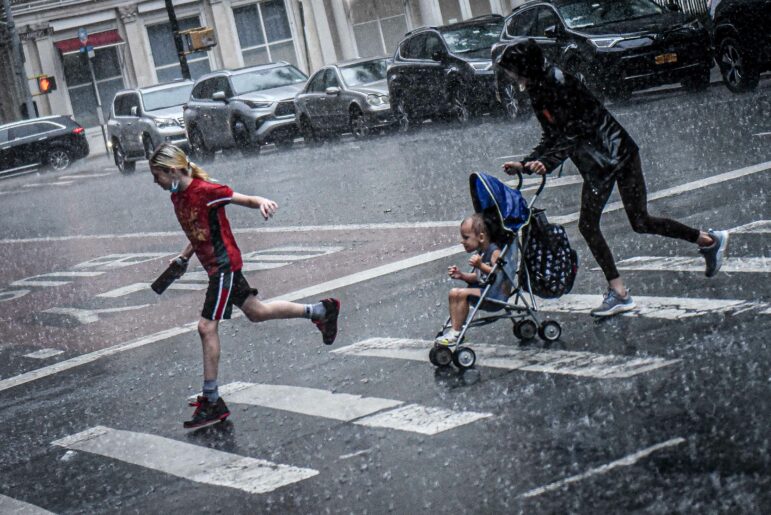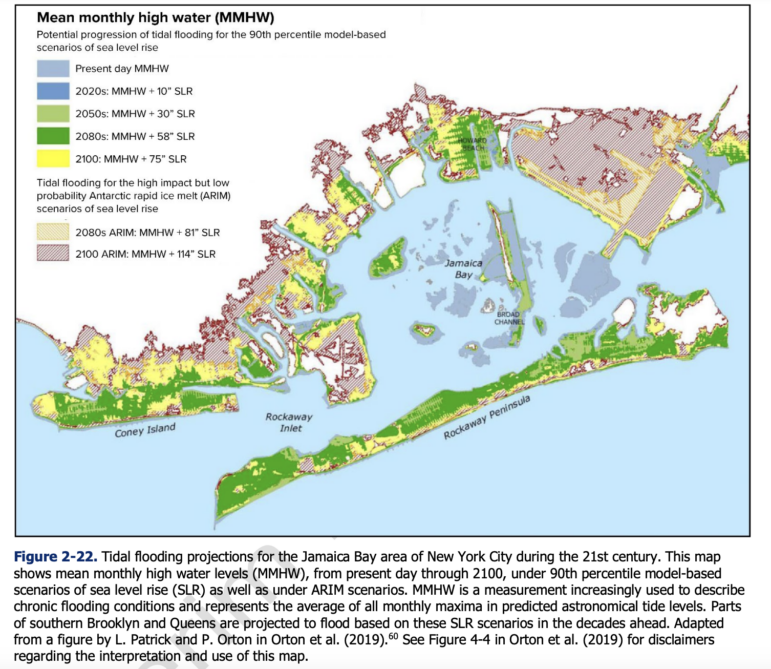A new state-wide report on the impacts of climate change shows New York City will be impacted on all fronts: The Big Apple is getting 6 to 10 degrees warmer, and will see more precipitation and tidal floods in the coming decades. “We have to understand that this stuff is going to happen, it’s already happening,” one state official said.

Michael Appleton/Mayoral Photography Office
Family gets caught in the rain on Broadway on June 27, 2022.A new report on the impacts of climate change released by the New York State Energy Research and Development Authority (NYSERDA) projects the Empire State will see an increase in coastal flooding, more severe storms, rainier days, and hotter temperatures.
And because New York City is located on the coast—and is the warmest region in the state as well as the wettest—it will face all of these challenges head on.
Coastal flooding caused by higher tides at sea will increase as the Big Apple, which now experiences 10 “high tide floods” annually, could see 60 to 85 days of tidal floods by the 2040s. Meanwhile, precipitation in the city is also expected to increase, while New York City is also on track to get 6 to 10 degrees hotter than it was between 1981 to 2010, the state’s projection found.
“We have to understand that this stuff is going to happen, it’s already happening. And we need to acknowledge that and prepare for what’s coming,” said Amanda Stevens, senior project manager at NYSERDA who spent four years putting together the report.
The study used internationally recognized global climate models and statewide data to paint a picture of what weather patterns will likely emerge on the local level.
The point, Stevens said, is to help decision makers across the state “prepare” and “adapt” communities so they can better withstand the impacts of climate change.
And the impacts promise to be substantial.
Sea level along New York’s coastline has risen almost one foot in the past century and is projected to increase by another one to two feet by mid-century. The state’s sea level is expected to continue to rise more than the global average, based on projections through 2150 for the northeastern U.S. coast.
In the southern tip of Manhattan’s water-front park known as The Battery, the sea level could increase between 14 to 19 inches by the 2050s and 30 to 50 inches by 2100 compared to where it was between 1995 and 2014.
As the sea level rises, so do the tides, which are more likely to spill over onto the city’s streets and cause flooding. Low-lying coastal areas, such as the Rockaways and other neighborhoods near Jamaica Bay, will be progressively affected by these tidal floods.

NYSERDA
Tropical storms and hurricanes also contribute to flooding. When a storm happens offshore, it can get so intense that water gets pushed inland through a process known as storm surge.
“The combination of sea level rise and storm surge will increase the frequency, extent, and severity of coastal flooding,” the report highlighted. “Coastal storms are also projected to become more intense over time.”
NYSERDA’s report was unable to calculate just how often hurricanes and other storms are likely to occur moving forward.
“The only thing that the models can say right now is that it’s likely that we’ll see stronger storms, but not necessarily a greater number of them,” Stevens explained.
Andra Garner, climate scientist and assistant professor at Rowan University who is an expert on coastal flooding in New York City, says global warming is a huge reason these storms are getting worse.
“When you’re warming up the planet, a lot of that warmth is going into the ocean and hurricanes really feed off of those nice warm ocean waters. So we’re just providing more fuel for storms to strengthen quickly, allowing them to intensify maybe faster than they used to in the past,” Garner said.
“So it’s not so much a matter of exactly when we’re going to see that next storm, but that we are continuing to stack the deck against ourselves by making it more likely that these really intense storms will happen more often in the future,” she added.
The NYSERDA report also predicts a lot more rain is headed this way. By 2050, days with more than one inch and days with more than two inches of precipitation are projected to become more frequent across the state.
Of the 12 regions assessed in the NYSERDA study, the largest increases in annual precipitation are expected for New York City, the Catskills, and South Hudson.
New York City will continue to be the wettest region in the state and annual precipitation is projected to increase by 4 to 11 percent by the 2050s and by 7 to 17 percent by the 2080s.
Average seasonal temperatures are also projected to increase across all regions of New York, with winter temperatures set to rise the most compared to where they were between 1981–2010.

NYSERDA
And when it comes to heat, New York City takes the prize as the state’s hottest region.
The Big Apple has historically experienced an average of four days per year over 95°F, the study highlights. By mid-century, it could see 14 to 32 days a year above that threshold, 17 to 54 days per year by the end of the century.
Extreme heat is already impacting New York City. Each summer, on average, an estimated 350 New Yorkers die prematurely due to heat related deaths, according to data published by the city’s Department of Health.
And low-income New Yorkers, city data shows, are particularly impacted by extreme heat as they “are less likely to own or use an AC during hot weather” because of associated utility costs.
“While more than 90% of NYC households currently have air conditioning, access can be as low as 76% in neighborhoods where more people are living with limited financial resources,” the city’s annual heat impact report highlights.
And as climate change accelerates, environmental advocates say vulnerable populations will continue to suffer the greatest blows.
“Communities of color and low income communities are getting hit first and worse because they are considered less high priority when it comes to investing in protecting them from climate change,” said Victoria Sanders, research analyst at the NYC Environmental Justice Alliance (NYC-EJA).
“They often have a lot less green infrastructure and trees to help them cool and to help absorb flood waters, for example. So when there’s flooding or when there’s a heatwave they don’t have the resources to respond as quickly,” she explained.
Sanders worries that the city won’t be equipped to weather the conditions forecasted in NYSERDA’s report.
“We have seen that the city is making efforts to address these concerns, but they aren’t scaling up that work quickly enough, and accounting for the rapidly changing things that are occurring,” she added. “The conditions are worsening at a rate that they aren’t able to keep up with.”
To reach the reporter behind this story, contact Mariana@citylimits.org. To reach the editor, contact Jeanmarie@citylimits.org








